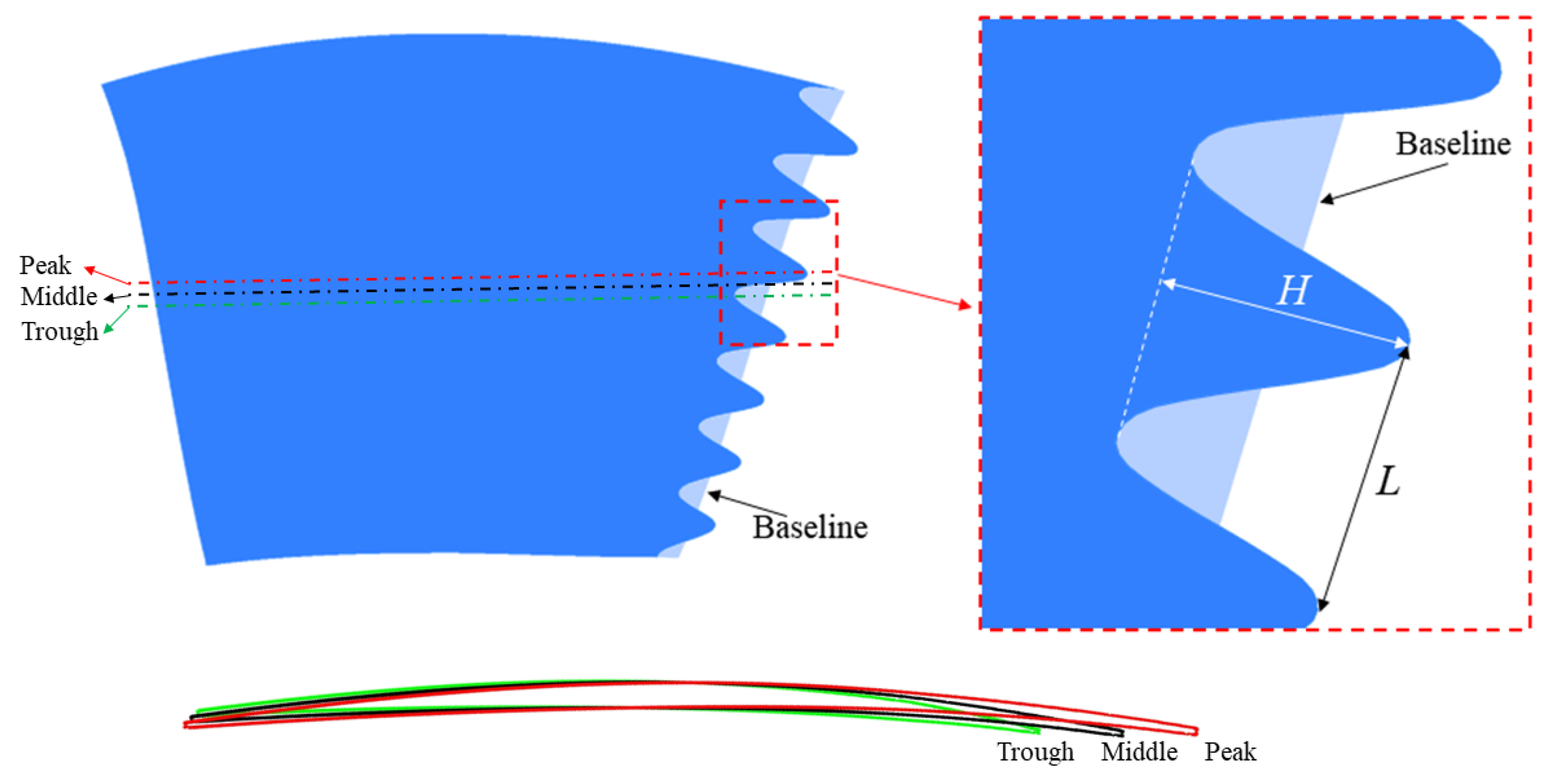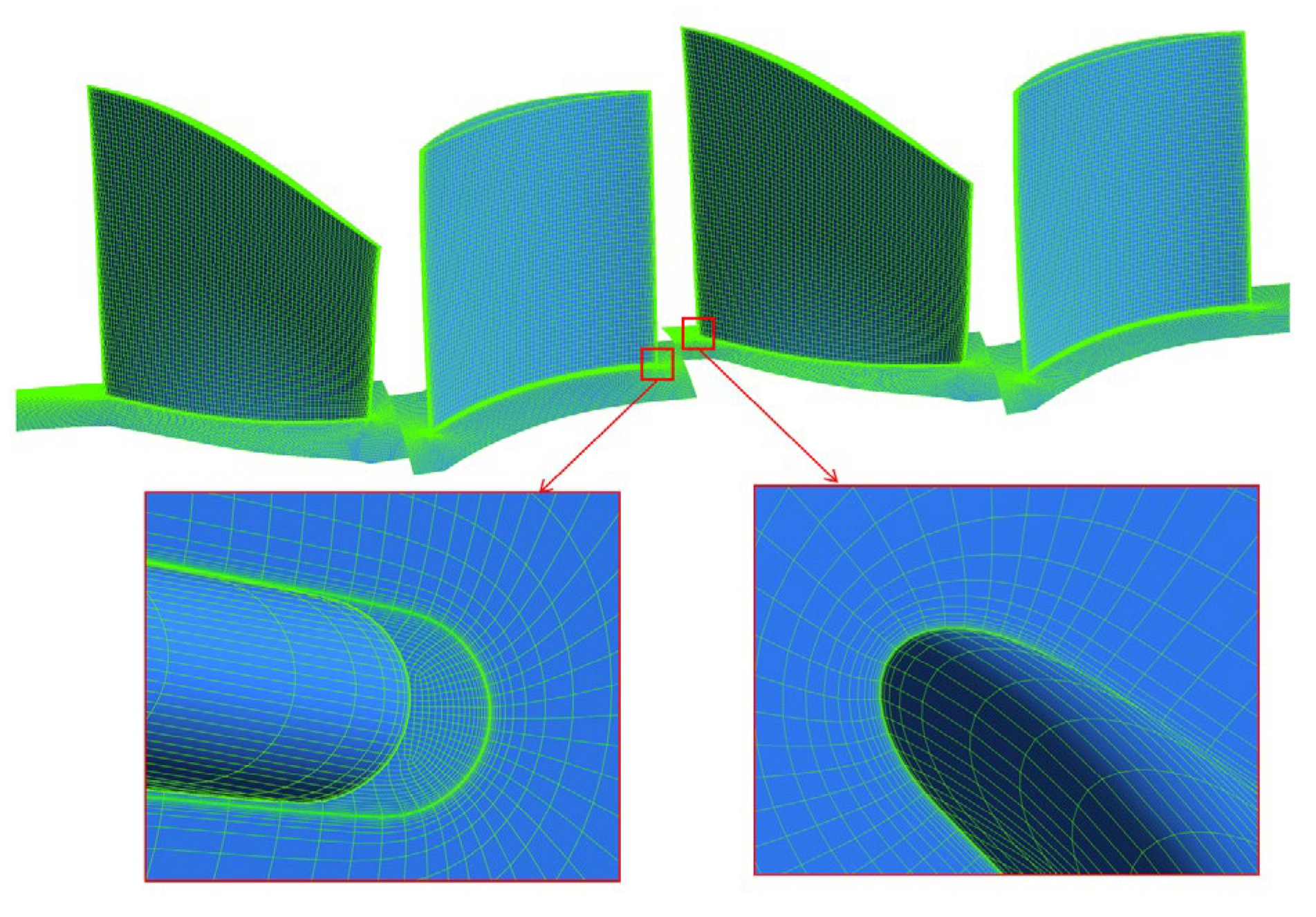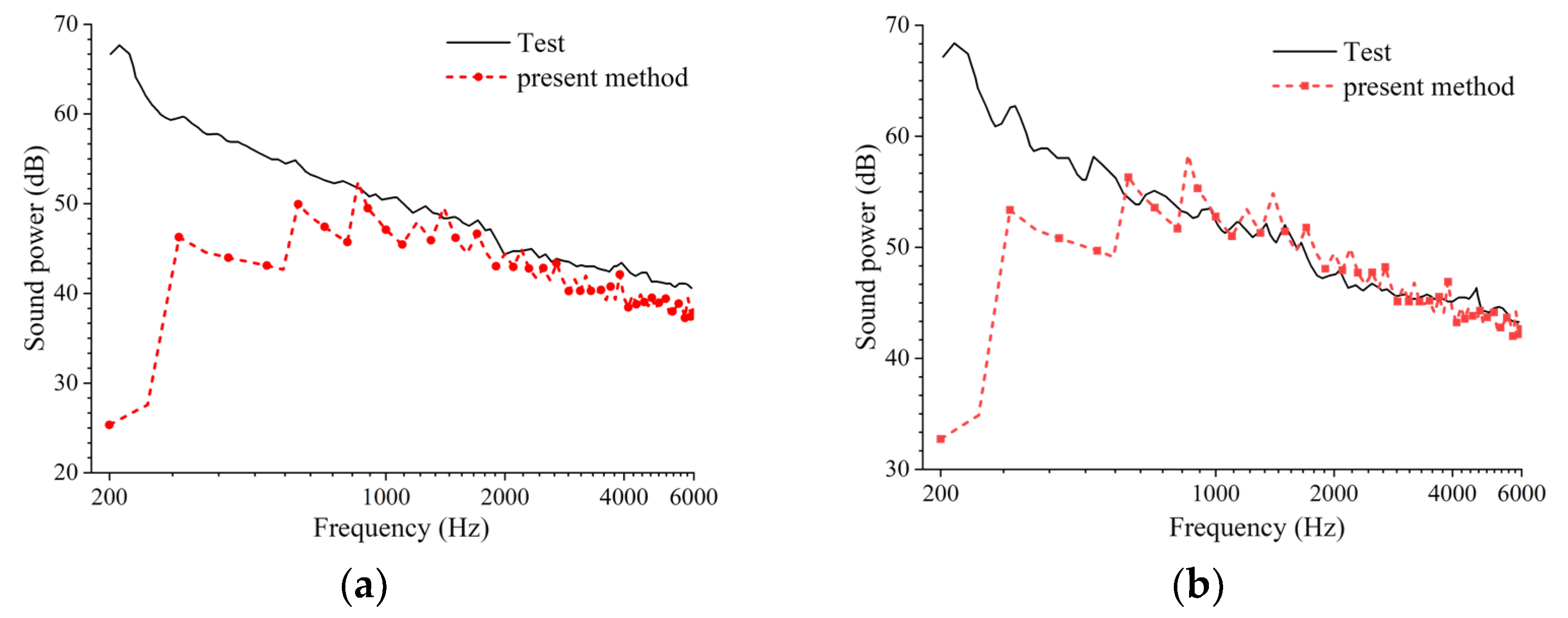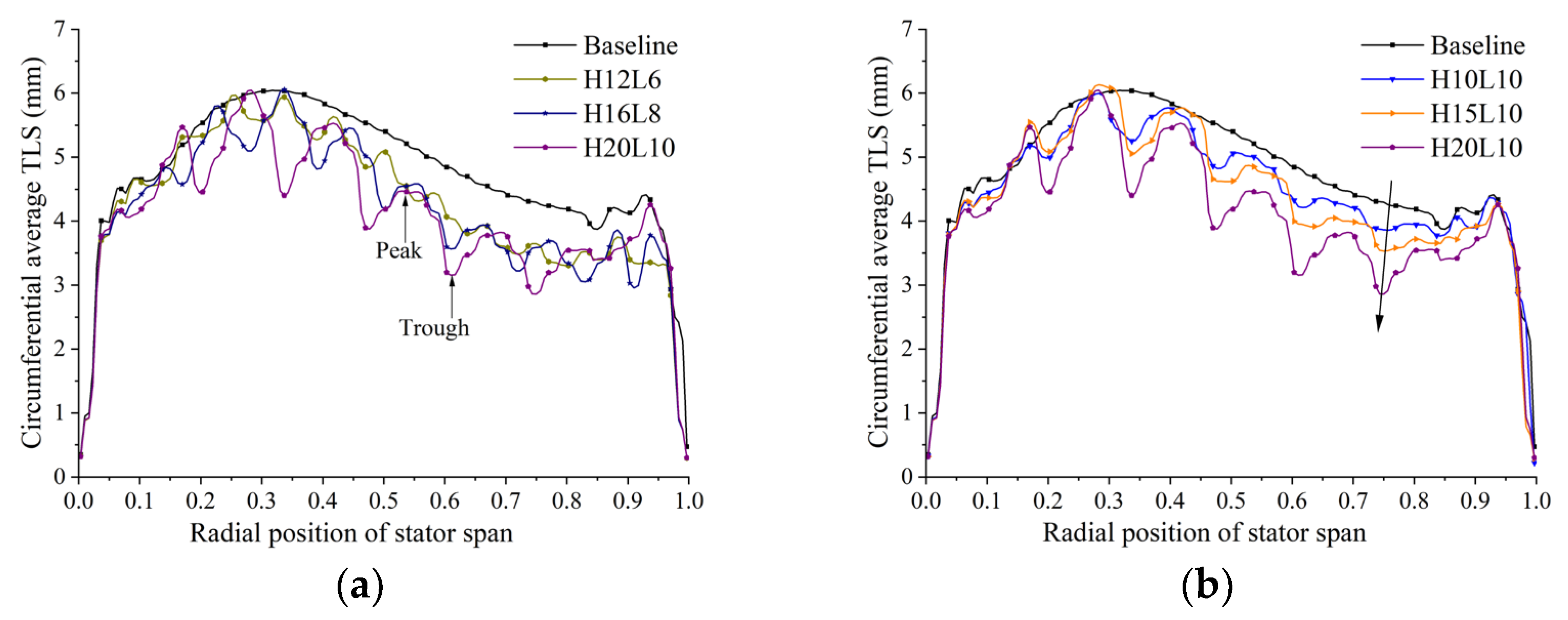Broadband Noise Reduction of a Two-Stage Fan with Wavy Trailing-Edge Blades
Abstract
:1. Introduction
2. Computational Methodology
2.1. Design of Wavy Trailing-Edge Blades
2.2. Aerodynamic Simulation by RANS
2.3. Broadband Noise Prediction Model
2.4. Mesh Independence Study
2.5. Validation of Noise Prediction Method
3. Results and Discussion
3.1. Effect of Bionic Blade on the Aerodynamic Performance
3.2. Effect of Bionic Blade on the Aeroacoustic Performance
3.3. Noise Reduction Mechanisms of the Wavy Trailing-Edge Blade
4. Conclusions
- (1)
- The wavy trailing-edge blade is less detrimental to the mean aerodynamic performance. The maximum efficiency reduction caused by H20L10 is 0.06%, and the total pressure ratio is reduced by 0.19%. The total pressure ratio of the bionic fan decreases with the increase in the wavelength and H/L, respectively. And the H/L is more detrimental to the total pressure ratio than the wavelength.
- (2)
- There are obvious R1–S1 interaction noise and S1–R2 interaction noise reduction effects for all the bionic fans in the low- and medium-frequency range (200~4000 Hz). However, this noise reduction is not significant for R2–S2 interaction noise. The H20L10 blade has the best noise reduction effect, with a noise reduction of 2.4 dB at 1000 Hz for R1–S1 interaction noise, a noise reduction of 1.4 dB at 1000 Hz for S1–R2 interaction noise, and a noise reduction of 0.5 dB at 1000 Hz for R2–S2 interaction noise. For R1–S1 interaction noise, the noise reduction effect of wavy trailing-edges increased with increasing wavelengths. When the H/L is 1 and 1.5, the wavy trailing-edges with a constant wavelength show negligible effects on the noise reduction. The noise reduction effect of wavy trailing-edges increases with an increase in the H/L from 1.5 to 2.
- (3)
- The TKE and TLS fluctuate along the radial span in front of the vanes, and the TKE and TLS are reduced by the wavy trailing-edge. The wake TKE fluctuates along the span in the wake of the bionic blades, and the wake TKE is reduced by the wavy trailing edge at the outer 40% of the blade radius. The intensive TKE region at the inner 60% of the blade radius gathers at one point, and decreases with increasing H/L. The wake vortex of the baseline blade is more dispersed than the H20L10 blade, which might be the reason for the TKE reduction along the span of the bionic blade.
Author Contributions
Funding
Data Availability Statement
Conflicts of Interest
References
- Nesbitt, E. Towards a Quieter Low Pressure Turbine: Design Characteristics and Prediction Needs. Int. J. Aeroacoustics 2011, 10, 1–16. [Google Scholar] [CrossRef]
- Owens, R. Energy Efficient Engine Performance System—Aircraft Integration Evaluation; NASA/CR 159488; Pratt and Whitney Aircraft: East Hartford, CT, USA, 1979. [Google Scholar]
- Johnston, R.; Hirschkron, R.; Koch, C.; Neitzel, R.E.; Vinson, P.W. Energy Efficient Engine-Preliminary Design and Integration Study; NASA CR-135444; NASA Technical Reports Server: Cleveland, OH, USA, 1978.
- Envia, E. Fan noise reduction: An overview. Int. J. Aeroacoustics 2001, 1, 43–64. [Google Scholar] [CrossRef]
- Huff, D.L. Noise Reduction Technologies for Turbofan Engines; NASA TM-2007-214495; NASA Technical Reports Server: Cleveland, OH, USA, 2007.
- Zhao, X.; Yang, M.; Zhou, J.; Lei, J. An algorithm to separate wind tunnel background noise from turbulent boundary layer excitation. Chin. J. Aeronaut. 2019, 32, 2059–2067. [Google Scholar] [CrossRef]
- Morin, B.L. Broadband fan noise prediction system for gas turbine engines. In Proceedings of the 5th AIAA/CEAS Aeroacoustics Conference and Exhibit, Bellevue, WA, USA, 10–12 May 1999. [Google Scholar]
- Fish, F.; Battle, J. Hydrodynamic design of the humpback whale flipper. J. Morphol. 1995, 225, 51–60. [Google Scholar] [CrossRef] [PubMed]
- Chen, W.; Wang, X.; Xing, Y.; Wang, L.; Qiao, W. Effect of wavy leading edges on airfoil tonal noise. Phys. Fluids 2023, 35, 097136. [Google Scholar] [CrossRef]
- Chen, W.; Qiao, W.; Duan, W.; Wei, Z. Experimental study of airfoil instability noise with wavy leading edges. Appl. Acoust. 2021, 172, 107671. [Google Scholar] [CrossRef]
- Xing, Y.; Chen, W.; Wang, X.; Tong, F.; Qiao, W. Effect of Wavy Leading Edges on Airfoil Trailing-Edge Bluntness Noise. Aerospace 2023, 10, 353. [Google Scholar] [CrossRef]
- Xing, Y.; Wang, X.; Chen, W.; Tong, F.; Qiao, W. Experimental Study on Wind Turbine Airfoil Trailing Edge Noise Reduction Using Wavy Leading Edges. Energies 2023, 16, 5865. [Google Scholar] [CrossRef]
- Chen, W.; Zhang, L.; Wang, L.; Wei, Z.; Qiao, W. Utilization of Whale-inspired Leading-edge Tubercles for Airfoil Noise Reduction. J. Bionic Eng. 2022, 19, 1405–1421. [Google Scholar] [CrossRef]
- Chen, W.; Qiao, W.; Tong, F.; Wang, L.; Wang, X. Experimental investigation of wavy leading edges on rod-aerofoil interaction noise. J. Sound Vib. 2018, 422, 409–431. [Google Scholar] [CrossRef]
- Han, J.; Zhang, Y.; Li, S.; Hong, W.; Wu, D. On the reduction of the noise in a low-pressure turbine cascade associated with the wavy leading edge. Phys. Fluids 2023, 35, 095103. [Google Scholar] [CrossRef]
- Tong, H.; Li, L.; Wang, L.; Mao, L.; Qiao, W. Investigation of rotor–stator interaction broadband noise using a RANS-informed analytical method. Chin. J. Aeronaut. 2021, 34, 53–66. [Google Scholar] [CrossRef]
- Casalino, D.; Avallone, F.; Martino, I.G.; Ragni, D. Aeroacoustic study of a wavy stator leading edge in a realistic fan/OGV stage. J. Sound Vib. 2019, 442, 138–154. [Google Scholar] [CrossRef]
- Chen, K.; Liu, Q.; Liao, G.; Yang, Y. The sound suppression characteristics of wing feather of owl (bubo bubo). J. Bionic Eng. 2012, 9, 192–199. [Google Scholar] [CrossRef]
- Howe, M. Noise produced by a sawtooth trailing edge. J. Acoust. Soc. Am. 1991, 90, 482–487. [Google Scholar] [CrossRef]
- Rong, J.; Jiang, Y.; Murayama, Y.; Ishibashi, R.; Murakami, M.; Liu, H. Trailing-edge fringes enable robust aerodynamic force production and noise suppression in an owl wing model. Bioinspir. Biomim. 2024, 19, 016003. [Google Scholar] [CrossRef] [PubMed]
- Song, B.; Xu, L.; Zhang, K.; Cai, J. Numerical study of trailing-edge noise reduction mechanism of wind turbine with a novel trailing-edge serration. Phys. Scr. 2023, 98, 065209. [Google Scholar] [CrossRef]
- Singh, S.; Narayanan, S. On the reductions of airfoil–turbulence noise by curved wavy serrations. Phys. Fluids 2023, 35, 075140. [Google Scholar] [CrossRef]
- Singh, S.; Narayanan, S. Control of airfoil broadband noise through non-uniform sinusoidal trailing-edge serrations. Phys. Fluids 2023, 35, 025139. [Google Scholar] [CrossRef]
- Du, J.; Lin, F.; Zhang, H.; Chen, J. Numberical investigation on the self-induced unsteadiness. J. Turbomach. 2010, 132, 021017. [Google Scholar] [CrossRef]
- Shi, Y.; Lee, S. Numerical study of 3-D finlets using Reynolds-averaged Navier-Stokes computational fluid dynamics for trailing edge noise reduction. Int. J. Aeroacoustics 2020, 19, 95–118. [Google Scholar] [CrossRef]
- Grace, S.; Wixom, A.; Winkler, J.; Sondak, D.; Logue, M. Fan broadband interaction noise modeling. In Proceedings of the 18th AIAA/CEAS Aeroacoustics Conference (33rd AIAA Aeroacoustics Conference), Colorado Springs, CO, USA, 4–6 June 2012; 2012. [Google Scholar]
- Ju, H.; Mani, R.; Vysohlid, M.; Sharma, A. Investigation of fan wake-ogv interaction broadband noise. In Proceedings of the 19th AIAA/CEAS Aeroacoustics Conference, Berlin, Germany, 27–29 May 2013; 2013. [Google Scholar]
- Smith, S.N. Discrete Frequency Sound Generation in Axial Flow Turbomachines; Report No.: 3709; ARC R. & M.: London, UK, 1972. [Google Scholar]
- Goldstein, M. Aeroacoustics; McGraw-Hill International Book Company: New York, NY, USA, 1976. [Google Scholar]
- Meyer, H.; Envia, E. Aeroacoustic Analysis of Turbofan Noise Generation; Report No.: NASA CR-4715; NASA: Washington, DC, USA, 1996.
- Posson, H.; Roger, M. Experimental validation of a cascade response function for fan broadband noise predictions. AIAA J. 2011, 49, 1907–1918. [Google Scholar] [CrossRef]
- Hanson, D.; Horan, K. Turbulence/Cascade Interaction: Spectra of Inflow, Cascade Response, and Noise; Report No.: AIAA-1998-2319; AIAA: Reston, VA, USA, 1998. [Google Scholar]
- Chen, W.; Qiao, W.; Wei, Z. Aerodynamic performance and wake development of airfoils with wavy leading edges. Aerosp. Sci. Technol. 2020, 106, 106216. [Google Scholar] [CrossRef]


















| Parameters | Data |
|---|---|
| R1 blades | 18 |
| S1 vanes | 20 |
| R2 blades | 22 |
| S2 vanes | 24 |
| Shroud diameter (mm) | 500 |
| Hub diameter (mm) | 300 |
| Tip clearance (mm) | 1 |
| Design speed (rpm) | 5000 |
| Design mass flow (kg/s) | 8.5 |
| Total pressure ratio | 1.1 |
| Model | L | H/L | H |
|---|---|---|---|
| H6L6 | 0.06c | 1 | 0.06c |
| H9L6 | 0.06c | 1.5 | 0.09c |
| H12L6 | 0.06c | 2 | 0.12c |
| H8L8 | 0.08c | 1 | 0.08c |
| H12L8 | 0.08c | 1.5 | 0.12c |
| H16L8 | 0.08c | 2 | 0.20c |
| H10L10 | 0.10c | 1 | 0.10c |
| H15L10 | 0.10c | 1.5 | 0.15c |
| H20L10 | 0.10c | 2 | 0.20c |
| Baseline | Elements Number () | |||
|---|---|---|---|---|
| Mesh1 | Mesh2 | Mesh3 | Mesh4 | |
| R1 | 0.65 | 0.88 | 1.35 | 2.31 |
| S1 | 0.69 | 0.94 | 1.33 | 1.94 |
| R2 | 0.52 | 0.70 | 1.01 | 1.53 |
| S2 | 0.87 | 1.36 | 1.74 | 2.70 |
| Total | 2.73 | 3.88 | 5.43 | 8.48 |
| γ | 1.1013 | 1.1014 | 1.1015 | 1.1015 |
| η | 89.1018 | 89.1530 | 89.1535 | 89.1547 |
| Model | η (%) | ηerror (%) | Model | η (%) | ηerror (%) | Model | η (%) | ηerror (%) | |||
|---|---|---|---|---|---|---|---|---|---|---|---|
| H6L6 | 1.53 | 89.1677 | 0.0082 | H8L8 | 1.69 | 89.1378 | 0.0465 | H10L10 | 1.69 | 89.1249 | 0.0132 |
| 2.01 | 89.1604 | --- | 2.11 | 89.1793 | --- | 2.06 | 89.1367 | --- | |||
| 2.54 | 89.1615 | 0.0012 | 2.67 | 89.7827 | 0.0038 | 2.61 | 89.1388 | 0.0024 | |||
| H9L6 | 1.73 | 89.1610 | 0.0324 | H12L8 | 1.70 | 89.1496 | 0.0430 | H15L10 | 1.78 | 89.1420 | 0.0037 |
| 2.06 | 89.1312 | --- | 2.03 | 89.1113 | --- | 2.14 | 89.1453 | --- | |||
| 2.34 | 89.1228 | 0.0094 | 2.34 | 89.1168 | 0.0062 | 2.55 | 89.1440 | 0.0015 | |||
| H12L6 | 1.51 | 89.1127 | 0.0092 | H16L8 | 1.49 | 89.1064 | 0.0726 | H20L10 | 1.48 | 89.0837 | 0.0149 |
| 2.05 | 89.1045 | --- | 2.11 | 89.1711 | --- | 2.05 | 89.0970 | --- | |||
| 2.61 | 89.1092 | 0.0053 | 2.70 | 89.2111 | 0.0449 | 2.49 | 89.0916 | 0.0061 |
| Model | L | H/L | (%) | (%) | ||
|---|---|---|---|---|---|---|
| Baseline | --- | --- | 1.1015 | --- | 89.15 | --- |
| H6L6 | 0.06c | 1 | 1.1012 | −0.03 | 89.16 | 0.01 |
| H9L6 | 0.06c | 1.5 | 1.1008 | −0.06 | 89.13 | −0.02 |
| H12L6 | 0.06c | 2 | 1.1002 | −0.12 | 89.11 | −0.04 |
| H8L8 | 0.08c | 1 | 1.1011 | −0.04 | 89.18 | 0.03 |
| H12L8 | 0.08c | 1.5 | 1.1005 | −0.09 | 89.11 | −0.04 |
| H16L8 | 0.08c | 2 | 1.0999 | −0.15 | 89.17 | 0.02 |
| H10L10 | 0.10c | 1 | 1.1009 | −0.05 | 89.14 | −0.01 |
| H15L10 | 0.10c | 1.5 | 1.1002 | −0.12 | 89.14 | −0.01 |
| H20L10 | 0.10c | 2 | 1.0994 | −0.19 | 89.10 | −0.06 |
Disclaimer/Publisher’s Note: The statements, opinions and data contained in all publications are solely those of the individual author(s) and contributor(s) and not of MDPI and/or the editor(s). MDPI and/or the editor(s) disclaim responsibility for any injury to people or property resulting from any ideas, methods, instructions or products referred to in the content. |
© 2024 by the authors. Licensee MDPI, Basel, Switzerland. This article is an open access article distributed under the terms and conditions of the Creative Commons Attribution (CC BY) license (https://creativecommons.org/licenses/by/4.0/).
Share and Cite
Gao, R.; Chen, W.; Tong, H.; Lian, J.; Qiao, W. Broadband Noise Reduction of a Two-Stage Fan with Wavy Trailing-Edge Blades. Aerospace 2024, 11, 374. https://doi.org/10.3390/aerospace11050374
Gao R, Chen W, Tong H, Lian J, Qiao W. Broadband Noise Reduction of a Two-Stage Fan with Wavy Trailing-Edge Blades. Aerospace. 2024; 11(5):374. https://doi.org/10.3390/aerospace11050374
Chicago/Turabian StyleGao, Ruibiao, Weijie Chen, Hang Tong, Jianxin Lian, and Weiyang Qiao. 2024. "Broadband Noise Reduction of a Two-Stage Fan with Wavy Trailing-Edge Blades" Aerospace 11, no. 5: 374. https://doi.org/10.3390/aerospace11050374





